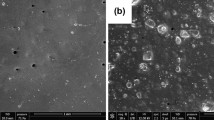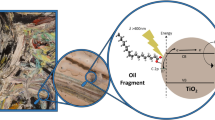Abstract
Pristine nanoparticles (NPs) may present a hazard to humans and the environment, and hence it is important to know to what extent NPs can be freely released from commercialized products in which they are added. The purpose of this study was to identify the parameters of the paint formulation containing SiO2 NPs of 19-nm diameter that could have an impact on the release induced by aging and abrasion. In order to simulate outdoor aging during the life cycle of the product, painted panels were exposed to accelerated weathering experiments in accordance with the norm EN ISO 16474-3:2013. The surface modification of these paints was characterized by scanning electron microscope coupled with energy dispersive spectrometry (SEM–EDS). These analyses showed that the acrylic copolymer binder has undergone a more significant chemical degradation compared with the styrene-acrylic copolymer. To simulate a mechanical aging, abrasion tests were conducted using a Taber Abraser, simulating critical scenarios of the abrasion standard. The particle size distributions and particle concentrations of the abraded particles were measured using an electric low-pressure impactor. After accelerated aging and abrasion tests, we observed a link between the paint degradations occurring with the release of pristine NPs and the embedded pristine NPs. Surface degradation of acrylic copolymer paints was more significant than that of the styrene-acrylic copolymer paints, and this induced a release of NPs 2.7 times higher. Other parameters like TiO2 addition as pigments induced a strong stability of paint against light and water, decreasing the total number of NPs released from paints from 30,000 to 1200 particles/cm3. These results revealed that formulations can be tuned to decrease the number of free NPs released and get a “safe-by-design” product.








Similar content being viewed by others
References
Allen NS, Edge M, Ortega A et al (2004) Degradation and stabilisation of polymers and coatings: nano versus pigmentary titania particles. Polym Degrad Stab 85:927–946. doi:10.1016/j.polymdegradstab.2003.09.024
Anjum N, Ajit Prasad SL, Suresha B (2013) Role of silicon dioxide filler on mechanical and dry sliding wear behaviour of glass-epoxy composites. Adv Tribol 2013:1–10. doi:10.1155/2013/324952
Chiantore O, Trossarelli L, Lazzari M (2000) Photooxidative degradation of acrylic and methacrylic polymers. Polymer (Guildf) 41:1657–1668
Christensen PA, Dilks A, Egerton TA (2000) Infrared spectroscopic evaluation of the photodegradation of paint Part II : the effect of UV intensity & wavelength on the degradation of acrylic films pigmented with titanium dioxide. J Mater Sci 35:5353–5358
Deka BK, Maji TK (2012) Effect of SiO2 and nanoclay on the properties of wood polymer nanocomposite. Polym Bull 70:403–417. doi:10.1007/s00289-012-0799-6
European Standard International Organization for Standardization (EN ISO) (2013) EN ISO 16474-3 paints and varnishes—methods of exposure to laboratory light sources—Part 3: fluorescent UV lamps. ISO, London
Feller RL (1994) Accelerating aging—photochemical and thermal aspects. The Getty Conservation Institute. Getty Publications, Los Angeles
Göhler D, Stintz M, Hillemann L, Vorbau M (2010) Characterization of nanoparticle release from surface coatings by the simulation of a sanding process. Ann Occup Hyg 54:615–624. doi:10.1093/annhyg/meq053
Golanski L, Guiot A, Pras M et al (2012) Release-ability of nano fillers from different nanomaterials (toward the acceptability of nanoproduct). J Nanopart Res 14:962. doi:10.1007/s11051-012-0962-x
Gorham JM, Nguyen T, Bernard C et al (2012) Photo-induced surface transformations of silica nanocomposites. Surf Interface Anal 44:1572–1581. doi:10.1002/sia.5075
Hirth S, Cena L, Cox G et al (2013) Scenarios and methods that induce protruding or released CNTs after degradation of nanocomposite materials. J Nanopart Res 15:1504. doi:10.1007/s11051-013-1504-x
International Organization for Standardization (ISO) (2006) ISO 7784-2:2006 paint and varnish—determination of resistance to abrasion Part 2: rotating abrasive rubber wheel method. ISO, London
International Organization for Standardization Technical Specification (ISO/TS) (2008) Nanotechnologies—terminology and definitions for nano-objects—nanoparticle, nanofibre and nanoplate. ISO, London
Kaegi R, Ulrich A, Sinnet B et al (2008) Synthetic TiO2 nanoparticle emission from exterior facades into the aquatic environment. Environ Pollut 156:233–239. doi:10.1016/j.envpol.2008.08.004
Kaiser J-P, Diener L, Wick P (2013) Nanoparticles in paints: a new strategy to protect façades and surfaces? J Phys 429:012036. doi:10.1088/1742-6596/429/1/012036
Khanna AS (2008) Nanotechnology in high performance paint coatings nanotechnology in coating. Asian J Exp Sci 21:25–32
Kuhlbusch TA, Asbach C, Fissan H et al (2011) Nanoparticle exposure at nanotechnology workplaces: a review. Part Fibre Toxicol 8:22. doi:10.1186/1743-8977-8-22
Long TC, Saleh N, Tilton RD, Gregory V (2006) Titanium dioxide (P25) produces reactive oxygen species in implications for nanoparticle. Environ Sci Technol 40:4346–4352
Marzaioli V, Aguilar-Pimentel JA, Weichenmeier I et al (2014) Surface modifications of silica nanoparticles are crucial for their inert versus proinflammatory and immunomodulatory properties. Int J Nanomed 9:2815–2832. doi:10.2147/IJN.S57396
Mizutani T, Arai K, Miyamoto M, Kimura Y (2006) Application of silica-containing nano-composite emulsion to wall paint: a new environmentally safe paint of high performance. Prog Org Coatings 55:276–283. doi:10.1016/j.porgcoat.2005.12.001
Nazari A, Riahi S (2011) Abrasion resistance of concrete containing SiO2 and Al2O3 nanoparticles in different curing media. Energy Build 43:2939–2946. doi:10.1016/j.enbuild.2011.07.022
Nguyen T, Pellegrin B, Bernard C et al (2011) Fate of nanoparticles during life cycle of polymer nanocomposites. J Phys 304:1–12. doi:10.1088/1742-6596/304/1/012060
Papliaka ZE, Andrikopoulos KS, Varella EA (2010) Study of the stability of a series of synthetic colorants applied with styrene-acrylic copolymer, widely used in contemporary paintings, concerning the effects of accelerated ageing. J Cult Herit 11:381–391. doi:10.1016/j.culher.2010.02.003
Patel SH (2010) Processing aids, in functional fillers for plastics. Second Edition. Magnesium. doi:10.1002/9783527629848.ch20
Peebles BC, Dutta PK, Waldman WJ et al (2011) Physicochemical and toxicological properties of commercial carbon blacks modified by reaction with ozone. Environ Sci Technol 45:10668–10675. doi:10.1021/es202984t
Raju BR, Suresha RPSB, Bharath KN (2012) The effect of silicon dioxide filler on the wear resistance of glass fabric reinforced epoxy composites. Adv Polym Sci 2:51–57
Riahi S, Nazari A (2011) Compressive strength and abrasion resistance of concrete containing SiO2 and CuO nanoparticles in different curing media. Sci China Technol Sci 54:2349–2357. doi:10.1007/s11431-011-4463-4
Saber AT, Jensen KA, Raun JN et al (2012) Inflammatory and genotoxic effects of nanoparticles designed for inclusion in paints and lacquers. Nanotoxicology 6:453–471
Sambhy V, MacBride MM, Peterson BR, Sen A (2006) Silver bromide nanoparticle/polymer composites: dual action tunable antimicrobial materials. J Am Chem Soc 128:9798–9808. doi:10.1021/ja061442z
Schlagenhauf L, Chu BTT, Buha J et al (2012) Release of carbon nanotubes from an epoxy-based nanocomposite during an abrasion process. Environ Sci Technol 46:7366–7372. doi:10.1021/es300320y
Shang J, Chai M, Zhu Y (2003) Solid-phase photocatalytic degradation of polystyrene plastic with TiO2 as photocatalyst. J Solid State Chem 174:104–110. doi:10.1016/S0022-4596(03)00183-X
Smulders S, Kaiser J-P, Zuin S et al (2012) Contamination of nanoparticles by endotoxin: evaluation of different test methods. Part Fibre Toxicol 9:41. doi:10.1186/1743-8977-9-41
Smulders S, Luyts K, Brabants G et al (2014) Toxicity of nanoparticles embedded in paints compared to pristine nanoparticles in mice. Toxicol Sci. doi:10.1093/toxsci/kfu112
The Project on Emerging Nanotechnologies (2013) Consumer products inventory. http://www.nanotechproject.org/cpi/
Vorbau M, Hillemann L, Stintz M (2009) Method for the characterization of the abrasion induced nanoparticle release into air from surface coatings. J Aerosol Sci 40:209–217. doi:10.1016/j.jaerosci.2008.10.006
Wohlleben W, Brill S, Meier MW et al (2011) On the Lifecycle of nanocomposites: comparing released fragments and their in-vivo hazards from three release mechanisms and four nanocomposites. Small 16:2384–2395. doi:10.1002/smll.201002054
Wu M, Wang M, Ge M (2009) Investigation into the performance and mechanism of SiO2 nanoparticles and starch composite films. J Text Inst 100:254–259. doi:10.1080/00405000701757677
Yang X, Liu J, He H et al (2010) SiO2 nanoparticles induce cytotoxicity and protein expression alteration in HaCaT cells. Part Fibre Toxicol 7:1. doi:10.1186/1743-8977-7-1
Zhou S, Wu L, Sun J, Shen W (2002) The change of the properties of acrylic-based polyurethane via addition of nano-silica. Prog Org Coatings 45:33–42. doi:10.1016/S0300-9440(02)00085-1
Zuin S, Gaiani M, Ferrari A, Golanski L (2013) Leaching of nanoparticles from experimental water-borne paints under laboratory test conditions. Environ Pollut 16:1–17
Acknowledgments
This work was funded by the European Commission within the Seventh Framework Program (FP7; 282 NanoHouse project—Grant Agreement no 247810). The author acknowledges the valuable assistance from Dr. David Cooper from CEA.
Conflict of interest
The authors declare no competing financial interest.
Author information
Authors and Affiliations
Corresponding author
Rights and permissions
About this article
Cite this article
Fiorentino, B., Golanski, L., Guiot, A. et al. Influence of paints formulations on nanoparticles release during their life cycle. J Nanopart Res 17, 149 (2015). https://doi.org/10.1007/s11051-015-2962-0
Received:
Accepted:
Published:
DOI: https://doi.org/10.1007/s11051-015-2962-0




